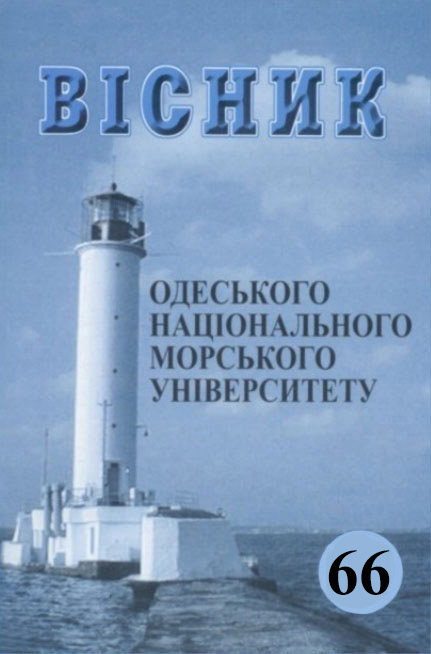Practice of application of dynamic geometry GeoGebra universities in teaching construction disciplines
Main Article Content
Abstract
The development of one of the teaching methods − distance learning − has recently become rapid and comprehensive. For teachers of higher educational institutions, especially technical specialties, which certainly include construction, there is a difficult task - how to transform educational material into modern digital forms, how to make the learning process flexible, exciting, convenient for the student and teacher. The practice of working with specialties of the construction direction at the Odessa National Maritime University has shown that one of the solutions is the use of the GeoGebra dynamic geometry tool. GeoGebra is a dynamic math program for all levels of education. Within the framework of higher educational institutions, it can be used in a number of general education disciplines, as well as special disciplines (theoretical mechanics, structural mechanics, building structures, hydrometry and engineering surveys, etc.) to solve a class of problems where a graph-analytical approach is in demand. GeoGebra can be
integrated into the popular Moodle distance education system as an independent component or used as a type of question for testing. The program has an extensive set of tools for performing various geometric constructions and calculations: points, segments, lines, rays, intersections, tangents, vectors, parallel translation, symmetry, angles, areas, etc. In addition, there are elements for managing the task and the environment. Within the framework of this article, a simple example of a graphical task (in the GeoGebra environment) is considered − the construction of a polygon of forces to determine the forces in the elements of the truss. It is proposed to perform a number of geometric constructions and thus find the missing vectors of efforts. It should be noted that this example is quite versatile and can be carried over to a number of other tasks requiring the use of vector addition. For example, when solving a vector problem to determine the average flow rate. In addition to graphical construction, it is shown how to prepare a task with dynamically changing initial data. This will avoid monotony when working with a task. In addition, an approach is presented for assigning marks in automatic mode. The teacher gets the opportunity to create an extensive set of graphical-analytical problems with a convenient interface for checking the work performed by students
Article Details
References
2. Elektronnyi resurs. Sait GeoGebra. URL: https://www.geogebra.org
3. Elektronnyi resurs. Pryklad vykonannia. URL:https://www.geogebra.org/classic/smwrwcfa
4. Verkhovod V.P. Yzuchenye kynematycheskoi heometryy ploskykh mekhanyzmov v Systeme GEOGEBRA/ Teoryia Mekhanyzmov y Mashyn. 2010. № 2. Tom 10. URL: http://tmm.spbstu.ru/20/7_verkhovod_20.pdf
5. Zyatdynov R.A. Heometrycheskoe modelyrovanye y reshenye zadach proektyvnoi heometryy v systeme GeoGebra // Materyalы konferentsyy «Molodezh y sovremennыe ynformatsyonnыe tekhnolohyy», Tomskyi polytekhnycheskyi unyversytet, h. Tomsk. 2010. S. 168-170. URL: http://msit.tpu.ru/files/conf_2010_p1.pdf
6. Zynyna A.Y. Yspolzovanye GeoGebra v obuchenyy matematyky v vuze / Dostyzhenyia y prylozhenyia sovremennoi matematyky y fyzyky / Materyalы VI Vserossyiskoi nauchno-praktycheskoi zaochnoi konferentsyy. 2017. Yzdatelstvo: Bashkyrskyi hosudarstvennыi unyversytet. URL: http://msit.tpu.ru/files/conf_2010_p1.pdf
7. Semenykhyna O.V., Durshlah M.H., Bezuhlыi D.S. Ynteraktyvnыe appletы kak sredstva kompiuternoi vyzualyzatsyy matematycheskykh znanyi y osobennosty ykh razrabotky v GeoGebra / Kompiuter v shkole y seme, 2016. URL: http://repository.sspu.sumy.ua/handle/123456789/1008.
8. Semenikhina O.V., Drushliak M.H. The Necessity to Reform Mathematics Education in Ukraine - 2015 - repository.sspu.sumy.ua. URL: https://repository.sspu.sumy.ua/bitstream/123456789/1025/1/journal-of-research-ininnovative-teaching-volume-8.pdf
9. Bezuhlыi D.S. Tekhnolohyia sozdanyia эlektronnoho uchebnyka s vstroennыmy ynteraktyvnumy apletamy / Fyzyko-matematycheskoe obrazovanye: nauchnui zhurnal / Mynysterstvo obrazovanyia y nauky Ukrayne, Sumskoi hosudarstvennui pedahohycheskyi unyversytet ymeny A.S. Makarenko, fyzyko-matematycheskyi fakultet - Sumy: SumHPU ymeny A.S. Makarenko, 2016. - Vup. 2 (8). - S. 23-28. URL: http://repository.sspu.edu.ua/handle/123456789/1016
